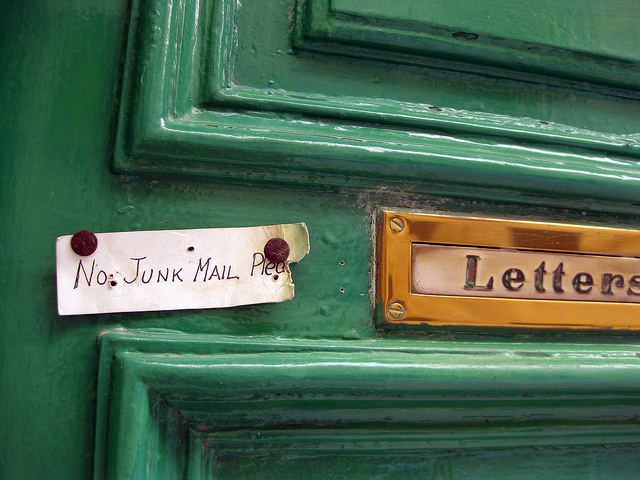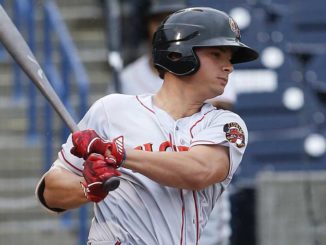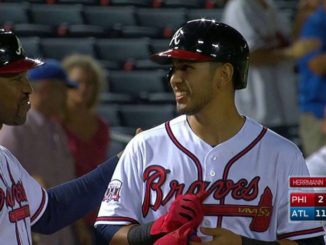
Answers On The Fly: A Reader Mailbag
Answers On The Fly is our weekly reader mailbag that features questions from you, the reader. These questions can be about the Atlanta Braves, the Georgia Bulldogs, bad movies, good beer, or (nearly) any other topic of your choice. Your questions will be answered by our crack staff of self-proclaimed experts who have diligently spent minutes upon minutes researching the answers. We urge you to join our dozens of readers and send us your questions.
Submit your questions the following ways:
- Email us
- Tweet us (@OFRSports)
- Post them in the Outfield Fly Rule Facebook group.
With the recent signings of pitchers, what does this do to the market in terms of young, controllable pitching and does this mean we’re going to keep stocking up on young pitching via trades once our players have developed into major league talent?
– Luis R.
San Diego, CA
Chris: David Price: 7-yrs/$217M (with an opt out after 3 years) from the Boston Red Sox. Zack Greinke: 6-yrs/$206.5M from the Arizona Diamondbacks. Jordan Zimmermann: 5-yrs/$110M from the Detroit Tigers. Jeff Samardzija: 5-yrs/$90M from the San Francisco Giants. John Lackey: 2-yrs/$32M from the Chicago Cubs. If that was a starting rotation for a team next year, they would be paid $121.4M (based on the average annual value of each deal).

Those are all answers to the question Atlanta Braves fans have asked in Facebook groups and comment sections for a year now: “Why do the Braves keep getting so many pitchers in trades?” Because it’s expensive as hell to get them as free agents. By far, the cheapest method of obtaining quality pitching is via draft or trade (with international free agency slightly behind). By accumulating young, cheap, controllable pitching, the Braves are not only hedging their bets against injury and performance issues, but salary escalation.
These large contracts could potentially drive the trade value of a guy like Shelby Miller higher. He’s a quality starting pitcher who is probably as good Zimmerman, better than Lackey or Samardzija, and not quite as good as Price or Greinke. Given the values of each of those deals, getting a starter like Miller for maybe $28M over the next three years (plus a couple of young players/prospects) would seem to be a huge discount off of the current market rate. Essentially, Miller will give a team Zimmermann-level production for three years for just over what Zimmermann will make next season alone. However, each of these signings means that a team that was looking for a front line starting pitcher probably no longer is. His value may increase slightly, but the potential trade partners decreased slightly, as well. Still, even mid- and small-market teams can afford $5M or $10M for a quality starter, so there are still suitors out there.
Here are how the current crop of free agent pitchers rank for their careers (Shelby Miller and Julio Teheran are included for comparison purposes):
| Rk | I | Player | W | L | CG | SHO | IP | HR | BB | SO | HBP | WP | |||||
|---|---|---|---|---|---|---|---|---|---|---|---|---|---|---|---|---|---|
| 8 | David Price | 3.10 | 104 | 56 | .650 | 14 | 3 | 1432.0 | 128 | 370 | 1362 | 34 | 29 | 1.135 | 8.6 | 3.68 | |
| 13 | Shelby Miller | 3.24 | 31 | 35 | .470 | 4 | 4 | 566.2 | 55 | 204 | 474 | 14 | 11 | 1.232 | 7.5 | 2.32 | |
| 16 | Johnny Cueto | 3.30 | 96 | 70 | .578 | 12 | 6 | 1420.1 | 145 | 410 | 1171 | 83 | 23 | 1.181 | 7.4 | 2.86 | |
| 18 | Jordan Zimmermann | 3.32 | 70 | 50 | .583 | 8 | 4 | 1094.0 | 104 | 221 | 903 | 42 | 15 | 1.159 | 7.4 | 4.09 | |
| 20 | Zack Greinke | 3.34 | 137 | 92 | .598 | 14 | 4 | 2035.0 | 191 | 490 | 1827 | 58 | 65 | 1.185 | 8.1 | 3.73 | |
| 26 | Julio Teheran | 3.41 | 40 | 30 | .571 | 4 | 2 | 625.2 | 73 | 176 | 537 | 26 | 5 | 1.191 | 7.7 | 3.05 | |
| 76 | John Lackey | 3.92 | 165 | 127 | .565 | 18 | 8 | 2480.1 | 260 | 709 | 1964 | 112 | 110 | 1.314 | 7.1 | 2.77 | |
| 109 | Jeff Samardzija | 4.14 | 37 | 55 | .402 | 7 | 3 | 846.1 | 100 | 241 | 773 | 36 | 37 | 1.248 | 8.2 | 3.21 |
Much like they did during the 1990s, I would expect the Braves to keep acquiring young pitching. It gives them a level of protection against injuries, poor performance, poor development, and losing pitchers to free agency. It also provides them young arms to use as currency in obtaining other players. Once the pipeline has been sufficiently primed to the point that there is a steady flow of talent again, I imagine the Braves would do as they did in the 1990s and attempt to extend quality young pitchers.
Dan: While I won’t go into detail the way Chris did, I’d still like to piggy-back off of what Chris said in his last paragraph.
The Braves of the 90’s prided themselves on their pitching depth. Tom Glavine, John Smoltz, Steve Avery, Tommy Greene, Derek Lilliquist, Kent Mercker, and Armando Reynoso headlined the 1990 Richmond Braves pitching depth. The GM during that year was Bobby Cox, whom took over as manager later on in the 1990 season. I’ve said before that Bobby’s role should be reduced a tad, but the “Johns” are assembling this 2016 roster much like they did the 1990 roster. 1990 was a bad season, finishing at 65-97. 2015 ended with a 67-95 record. In 1991 the Braves were National League Champs. The plan all along was to build toward 2017. If Bobby Cox can channel the magic from 1990, along with John Hart, John Coppolella, and President John, I suspect all these pitchers who they probably like a ton will hang around. All these other guys who have seemed like head-scratching signings or throw-ins, will be flipped for position players that can develop into long time, Major League ball players.
I know this doesn’t really address the question, but I think it addresses the resounding narratives right now: “Why so many pitchers? We need offense and offense with some pop!” And “If the Braves sign or trade for one more pitcher, I swear, I’ll …”. The front office guys know what they’re doing, so be patient. It’s December 5th and the Winter Meetings start Monday. I have a feeling good things are about to happen, especially with all these pitchers driving up the value of the field. The Braves are sitting really pretty right now. They have what everybody else wants, pitching and CONTROLLABLE pitching is what Atlanta has plenty of.
[sc:InContentResponsive ]
Why not Ian Desmond? Fills a void at 2nd or 3rd and strokes the ball.
– Benjamin R.
Centralia, MO
Chris: Desmond has never played 3B in his professional career, so I wouldn’t say he fills a void there. And his SS play is so treacherous at times that he’s likely to see as much time at 2B next season as SS, despite being probably the best SS available in free agency. Despite that, Desmond has been a solid offensive performer at a position that has few of them. His career wRC+ of 100 marks him as an exactly league average bat, but makes him top 10 among SS since 2009. Desmond also provides a little power from a position that rarely offers any.
However, he’s showing clear and obvious signs of decline, too. His strikeout rate, which was already slightly high, has increased each year since 2012, with a rather significant jump from 2013 to 2014. He’s been close to a 30% K-rate for two seasons. In 2015, he saw a drop in Hard Hit balls and an increase in Softly Hit balls, and he struggled with fastballs. His power, as measured by ISO, also dropped. For me, those are signs of declining skills that would cause me to be extremely cautious.
Desmond is a player entering his thirties who is already showing signs of decline with both the bat and the glove, although he still grades out overall as a roughly league average defender. His contract this off-season has been estimated at anywhere from 5-yrs/$70M ($14M AAV) to 4-yrs/$60M ($15 AAV) to 5-yrs/$85M ($17M AAV). That strikes me as quite a bit to pay an aging, declining player. And that’s without considering the draft pick (#35 overall, I believe) that will have to be forfeited if he is signed (Desmond declined a Qualifying Offer from the Washington Nationals).
Dan: I can speak a little more to this guy. I live in Maryland right now, smack dab in between DC and Baltimore. I get Nationals broadcasts and radio … It’s actually quite sickening. However, the justification and rationale from Chris is shared in DC on Desmond. Desmond is a guy the Nats liked, but didn’t love. They weren’t too concerned with him going to free agency. They have Danny Espinosa, Anthony Rendon, and Trea Turner who they LOVE! I don’t see Desmond as being really any better than what we already have, and what we have is younger or about the same age. Desmond’s steady decline isn’t worth the price he will want. I believe he’s over-hyped and a disappointment waiting to happen. Someone will overpay for him, just as long as it isn’t us.
[sc:InContentResponsive ]
What are Coppolella’s strengths as a GM? If he has any weaknesses what are they?
– Clint C.
Douglasville, GA
Chris: Coppolella’s clear weakness is his inexperience. To a lesser extent, he probably lacks some of the contacts and ‘gravitas’ that a GM like John Hart or John Schuerholz has developed over their careers. Being a relative unknown to most Braves fans, Coppolella likely doesn’t have the margin of error that a more established general manager would have. And, judging by recent comments in interviews, Coppolella still has some learning to do with regards to speaking publicly.
That said, Coppolella does have some strengths. He’s been very highly thought of for years around not just the Braves, but all of MLB. He’s consistently been listed on various lists of ‘up and coming’ general managers, as we highlighted last year when Frank Wren was fired. Coppolella also has hands on experience, largely being the brains behind some of the large trades the Braves have made. And while some think of him as an ‘analytics’ oriented GM (Coppolella reportedly created some of the in-house metrics used by the Braves), he actually game up through the New York Yankees scouting division. He’s the rare GM who has a blend of both ‘old school’ and ‘new school’ thinking.
Dan: I’d like to add though, that with his inexperience, Hart, Schuerholz, and Cox have those contacts that Coppy doesn’t have. You have to think Coppy isn’t making these calls all on his own. He has some serious clout in his corner, and very well versed experience helping him out. What he lacks in experience, they more than make up for it.
[sc:InContentResponsive ]
What do you think about the trade for Jose Ramirez? Also do you know who the Braves dealt to Seattle?
– RC H.
Elkhorn, NE
Chris: On Friday, the Braves acquired Seattle Mariners pitcher Jose Ramirez for a Player To Be Named Later and/or cash considerations. As of this moment, the Braves have not sent anything or anyone to Seattle. The return will likely be determined near the start of the season (dependent on if Ramirez makes the big league club) or closer to the trade deadline (after the teams have had a chance to weigh his contributions).
Ramirez has a huge fastball, often hitting 100 MPH. But like Mauricio Cabrera and Juan Jaime, he often has no idea where that fastball is going. Ramirez has only pitched 17.2 IP in the big leagues, so it is still an incredibly small sample size, but he has had serious control problems thus far. He has a 2.434 WHIP, driven by a huge 8.7 BB/9 walk rate. He’s a project, he’s an extremely low risk acquisition, and he could be lightning in a bottle. So far, we’ve acquired him for nothing. And what we give up will likely be a comparable D-level prospect, unless he manages to harness that fastball. Ramirez is out of options, so he will have to be on the big league roster or be exposed to waivers.
Many of the signings announced between the end of the season and the start of the season are simply depth signings. Not every deal that we see announced is necessarily for the big league club. The Braves have affiliates at several levels for which they are required to provide players. Ramirez will get a chance to prove himself in spring, but if he is lost to waivers, it isn’t a big loss.
Dan: As long as the PTBNL isn’t Crash Davis, I think we’ll be OK. I doubt Ramirez is with the big club to start the year. He comes cheap so it’s low risk, possibly high reward. However, that being said, whomever we do send back, if it is a player, I doubt it’s anyone from the 40-Man.




Leave a Reply